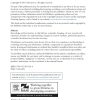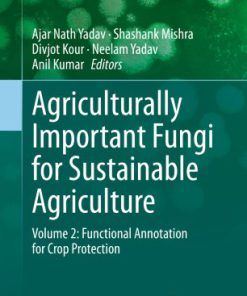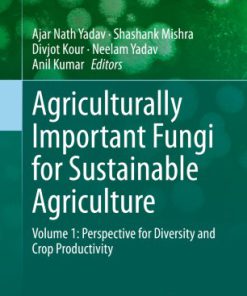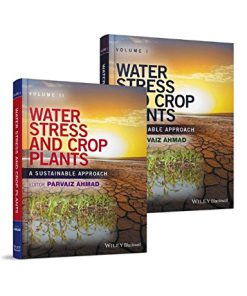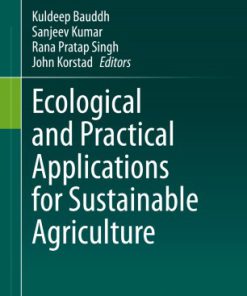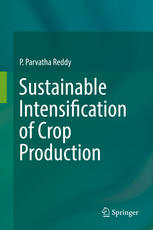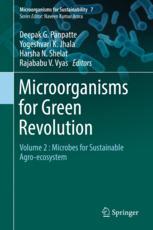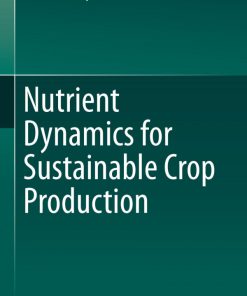Agriculturally Important Microbes for Sustainable Agriculture Volume 2 Applications in Crop Production and Protection 1st Edition by Arunava Pattanayak 9811053436 9789811053436
$50.00 Original price was: $50.00.$25.00Current price is: $25.00.
Agriculturally Important Microbes for Sustainable Agriculture Volume 2 Applications in Crop Production and Protection 1st Edition by Arunava Pattanayak – Ebook PDF Instant Download/DeliveryISBN: 9811053436, 9789811053436
Full download Agriculturally Important Microbes for Sustainable Agriculture Volume 2 Applications in Crop Production and Protection 1st Edition after payment.

Product details:
ISBN-10 : 9811053436
ISBN-13 : 9789811053436
Author: Arunava Pattanayak
This book is a compilation of case studies from different countries and covers contemporary with future prospective for sustainable development of agriculture. The book highlights the real-world as well as future generation situations facing the challenges for the twenty first century will be production of sufficient food and highlights the strengths, weaknesses and opportunities, to meet the needs of fast growing population it is imperative to increase agricultural productivity in an environmentally sustainable manner. Due to imbalanced use of chemical fertilizers and agrochemicals has a considerable negative impact on economy and environmental sustainability of nation, for the sustainable alternative means to solve these problems, the efficient utilization of biological agents have been extensively studied. Naturally existing plant-microbe-environment interactions are utilized in many ways for enhancing plant productivity. A greater understanding of how plants and microbes live together and benefit each other can therefore provide new strategies to improve plant productivity, in most sustainable way. To achieve the objective of sustainable agricultural practices there is a need for understanding both basic and applied aspects of agriculturally important microorganisms. Focus needs to be on transforming agricultural systems from nutrient deficient to nutrient rich soil-plant system. This book is split into two parts, with an aim to provide comprehensive description and highlight a holistic approach. It elucidated various mechanisms of nutrients solubilisation and its importance in enhancement of plant growth, nutrient content, yield of various crops and vegetables as well as soil fertility and health. Unit-1 in this book explains the importance of soil microbes in sustainable crop production. It contains chapters detailing the role and mechanism of action of soil microbes which enhances the productivity via various bio-chemical and molecular channels. In unit-2 the role of microbes in plant protection is elaborated. With the help of case studies of food crops, multiple ways in which soil microbes help in fighting and preventing plant diseases is explained. With the given content and layout book will be an all-inclusive collection of information, which will be useful for students, academicians, researchers working in the field of rhizospheric mechanisms, agricultural microbiology, soil microbiology, biotechnology, agronomy and sustainable agriculture and also for policy makers in the area of food security and sustainable agriculture.
Agriculturally Important Microbes for Sustainable Agriculture Volume 2 Applications in Crop Production and Protection 1st Table of contents:
Part I: Microbes for Sustainable Food Production
1: Importance of Soil Microbes in Nutrient Use Efficiency and Sustainable Food Production
1.1 Introduction
1.2 A Way Toward Healthy Soil: Integrated Soil Fertility Management
1.3 Soil Carbon: A Key to Sustainability
1.4 The Soil–Microbe System
1.5 Seed Inoculants/Biopriming for Use in Agriculture
1.6 The Rhizosphere: An Unknown World
1.7 Use of Arbuscular Mycorrhizal Fungi
1.8 Conclusions
References
2: Nutrient Solubilizing Microbes (NSMs): Its Role in Sustainable Crop Production
2.1 Introduction
2.2 Nitrogen
2.2.1 Nitrogen Status in Soil
2.2.2 Organic Nitrogen
2.2.3 Inorganic Nitrogen
2.2.4 Role of Nitrogen in Plants
2.2.5 Deficiency and Excess of Nitrogen
2.2.6 Nitrogen-Fixing Rhizobacteria
2.2.7 Symbiotic Nitrogen-Fixing Rhizobacteria
2.2.8 Rhizobium (Family: Rhizobiaceae)
2.2.9 Non-symbiotic Nitrogen-Fixing Rhizobacteria
2.2.9.1 Azotobacter (Family: Azotobacteriaceae)
2.2.9.2 Azospirillum (Family: Spirillaceae)
2.2.9.3 Acetobacter (Family: Acetobacteriaceae)
2.2.9.4 Azoarcus
2.3 Phosphorus
2.3.1 Phosphorus Status in Soils
2.3.2 Role of Phosphorus in Plants
2.3.3 Phosphorus Fixation in Soils
2.3.4 P-Solubilizing Rhizobacteria (PSR)
2.3.5 Mechanism of P-Solubilizing Rhizobacteria
2.4 Potassium
2.4.1 Potassium (K) Status in Soil
2.4.2 Role of Potassium in Plants
2.4.3 K-Solubilizing Rhizobacteria
2.4.4 Mechanism of K-Solubilizing Rhizobacteria
2.5 Zinc
2.5.1 Zinc Status in Soils
2.5.2 Role of Zinc in Plants
2.5.3 Deficiency of Zinc in Plants
2.5.4 Zn-Solubilizing Rhizobacteria (ZSR)
2.5.5 Mechanism of Zn-Solubilizing Rhizobacteria
2.6 Silicon
2.6.1 Silicon Status in Soils
2.6.2 Role of Silicon in Plants
2.6.3 Si-Solubilizing Rhizobacteria (SSR)
2.6.4 Mechanism of Si-Solubilizing Rhizobacteria
2.7 Role of Biotechnology to Develop Efficient Strain of Microorganism for Solubilization
2.8 Concluding Remarks
References
3: Implementation of Biofortification Technology by Using PGPR for Sustainable Agricultural Produc
3.1 Introduction
3.2 Types of Nutrients and Their Importance for Plant Growth Enhancement
3.3 Various Combinations of Interactions for Nutrient Uptake
3.3.1 Rhizobacterial Interactions
3.3.2 Fungal Interactions
3.3.3 Actinomycetes Interactions
3.3.4 Cyanobacterial Interactions
3.4 Role of Biofortifications for Enhancement of Nutrients
3.5 Current Perspectives of PGPR Toward Biofortifications
3.6 Conclusions and Future Prospective
References
4: Biological Nitrogen Fixation for Sustainable Agriculture
4.1 Introduction
4.2 Diversity Among Nitrogen-Fixing Bacterial (NFB) Groups
4.2.1 Blue-Green Algae (Cyanobacteria)
4.2.2 Lichens
4.2.3 Associative N2 Fixers
4.2.4 Rhizobium-Legume Symbiosis
4.2.5 N2-Fixing Nonlegumes
4.2.6 Stem-Nodulating Legumes
4.3 Contribution of Fixed Nitrogen by Various Bacteria to Cereal and Legume Crops
4.4 Environmental Factors Affecting Nitrogen Fixation
4.5 Biochemistry, Genetics, and Regulation of Nitrogen Fixation
4.5.1 Biochemistry of Nitrogen Fixation
4.5.2 Nitrogenase Enzyme Complex
4.5.3 Mechanism of Nitrogenase Action
4.5.4 Genetics of Nitrogenase
4.5.5 Regulation of Nitrogenase
4.5.5.1 Activation of nif Transcription
4.5.5.2 Repression of nif Transcription
4.5.5.3 Sequencing of nif Promoters and Regulatory Genes
4.6 Strategies for Improving N2 Fixation
4.6.1 Enhancement of Nodulation and Broadening of Host Range
4.6.1.1 Transfer of Symbiotic Plasmid
4.6.1.2 Transfer of Cloned nod Genes
4.6.2 Enhancement of Nitrogen Fixation
4.6.3 Nodulation and Nitrogen Fixation in Nonlegume Hosts
4.6.4 Incorporation of nif Gene in Eukaryotes
4.6.5 Protoplast Fusion Technique
4.6.6 Performance and Limitations of Genetically Manipulated Inoculant Strains
4.7 Conclusions
References
5: Arbuscular Mycorrhizal Symbiosis and Its Role in Plant Nutrition in Sustainable Agriculture
5.1 Introduction
5.2 General Concepts in Mycorrhizal Status: An Overview
5.2.1 Mycorrhiza Symbiosis Categories
5.2.2 Taxonomic Diversity of Arbuscular Mycorrhizal Fungi
5.2.3 Morphology and Reproduction
5.2.4 Development of the Arbuscular Mycorrhizal Association and Root Colonization
5.2.5 Plant Strategy to Acquire Inorganic Phosphate from the Environment
5.2.5.1 Regulation of Arbuscular Mycorrhizal Development by Phosphate Availability
5.3 Sustainability and Agricultural Sustainability
5.4 Plants Under Abiotic Stress
5.4.1 Plants and Salinity Stress
5.4.1.1 Effect of Arbuscular Mycorrhizal Fungi on Nutrient Uptake by Salt-Stressed Plants
5.4.1.1.1 Nitrogen
5.4.1.1.2 Phosphorus
5.4.1.1.3 The K+ to Na+ Ratio
5.4.1.1.4 Calcium
5.4.2 Plants and Drought Stress
5.4.2.1 Effect of Arbuscular Mycorrhizal Fungi on Nutrient Uptake by Drought-Stressed Plants
5.4.3 Plants and Heavy Metals
5.4.3.1 Metallophyte Plants
5.4.3.2 Phytoremediation
5.4.3.3 Effect of Arbuscular Mycorrhizal Fungi on Nutrient Uptake by Heavy Metal–Stressed Plan
5.4.4 Plants and Acidity Stress
5.4.4.1 Plants and Aluminum Toxicity
5.4.4.2 Aluminum Toxicity and Arbuscular Mycorrhizal Symbiosis
5.4.4.3 Plants and Manganese Toxicity
5.4.4.4 Manganese Toxicity and Arbuscular Mycorrhizal Symbiosis
5.4.5 Importance of Mycorrhizosphere Interactions to Sustainable Agriculture
5.4.5.1 Arbuscular Mycorrhizal Fungus Inoculants
5.5 Conclusion and Future Prospects
References
6: Paenibacillus polymyxa: A Prominent Biofertilizer and Biocontrol Agent for Sustainable Agricult
6.1 Introduction
6.2 Brief History of Paenibacillus polymyxa (Formerly Bacillus polymyxa)
6.3 P. polymyxa Strains Isolated from Agricultural Crops
6.4 Complete Genome Sequencing of P. polymyxa Strains
6.5 Plant Growth Promotion by Paenibacillus polymyxa Strains
6.5.1 Biofertilization: Direct Plant Growth Promotion
6.5.2 Biocontrol: Indirect Plant Growth Promotion
6.6 Field Studies and Commercial Availability of Paenibacillus polymyxa Strains
6.7 Concluding Remark and Future Prospective
References
Part II: Microbes for Sustainable Crop Protection
7: Role of Pseudomonas sp. in Sustainable Agriculture and Disease Management
7.1 Introduction
7.2 Rhizosphere and Their Interaction with Microbes
7.3 Pseudomonas as a PGP Agent in Plant Growth
7.4 Mechanism of Pseudomonas Action in Plant Growth Promotion
7.4.1 Phosphate Solubilization
7.4.2 Siderophore Production
7.4.3 Modulating Phytohormone Levels
7.4.4 Indole Acetic Acid
7.5 Role of Pseudomonas in Disease Management
7.6 Mechanism of Biocontrol by Pseudomonas Strains
7.6.1 Production or Synthesis of Antibiotics
7.6.2 Production of Cell Wall-Degrading Enzymes
7.6.3 Pseudomonas in Induced Systematic Resistance (ISR)
7.6.4 Regulation of Pseudomonas Functions by Signaling Molecules
7.7 Interaction of Pseudomonas with Other Microbe in Rhizosphere
7.8 Concluding Remarks
References
8: Role of Nutrients in Controlling the Plant Diseases in Sustainable Agriculture
8.1 Introduction
8.2 Role of Nutrients in Reducing Disease Severity
8.2.1 Nitrogen (N)
8.2.2 Phosphorus (P)
8.2.3 Potassium (K)
8.2.4 Calcium (Ca)
8.2.5 Magnesium (Mg)
8.2.6 Micronutrients
8.2.7 Other Nutrients
8.3 Control of Diseases Through Sustainable Nutrient Management
8.4 Systemic Induced or Acquired Resistance
8.5 Disease Resistance Through Sustainable Practices
8.5.1 Soil Organic Matter/Amendments
8.5.2 Intercropping
8.5.3 Crop Rotation
8.6 Concluding Remarks and Future Perspective
References
9: Integrated Mechanisms of Plant Disease Containment by Rhizospheric Bacteria: Unraveling the Sig
9.1 Introduction
9.2 PGPR in Disease Containment
9.2.1 Pseudomonas: The Supreme Diverse Group
9.2.2 Pseudomonas as Plant Growth-Promoting Agents
9.2.2.1 Direct Phyto-augmentation Mechanisms
9.2.2.2 Indirect Phyto-augmentation Mechanisms
9.2.2.2.1 Production of Siderophores
9.2.3 Biofilm Formation and Bacterial Signal Cross Talk
9.2.3.1 Detoxification and Degradation of Virulence Factors
9.2.3.2 Through Reduction of Biotic and Abiotic Stress
9.2.3.3 Production of Mycolytic Enzymes
9.2.3.4 Secretion of Chemical Volatiles
9.3 Mechanism of Antibiosis
9.4 Host Specific Signal Variations Associated with Microbial Priming
9.5 Conclusions
References
10: Toward Plant Defense Mechanisms Against Root Pathogens
10.1 Introduction
10.2 The Beneficial Plant Microbiome
10.3 Dynamics of Plant-Microbe Interactions
10.4 Emerging Agricultural Plant Pathogens
10.5 Plant Disease and Resistance
10.6 The Plant Immune System
10.7 Plant Defense Hormones
10.8 Defense Against the Root Pathogen Fusarium oxysporum
10.9 Defense Against F. oxysporum in Arabidopsis
10.10 Progress on the use of PGPR as Biocontrol Agents Against Root Pathogens
10.11 Induced Systemic Resistance (ISR) as a Mechanism of Disease Suppression by Rhizobacteria
10.12 Conclusions and Future Directions
References
11: Attempts for Biological Control of Ralstonia solanacearum by Using Beneficial Microorganisms
11.1 Biological Control of Plant Pathogens
11.2 Ralstonia solanacearum: Distribution and Classification Systems
11.2.1 Introduction and Distribution
11.2.2 Classification Systems
11.2.2.1 Based on Host Range: Five Races (Buddenhagen et al. 1962; He et al. 1983)
11.2.2.2 Based on Utilization/Oxidation of Certain C Sources
11.2.2.3 Based on Phylogenetic Analysis
11.2.2.4 Based on Endoglucanase (Egl) Gene Sequence
11.2.2.5 Based on RFLP and Other Genetic Fingerprinting Studies
11.2.2.6 New Classification into Three Species (Genin and Denny 2012)
11.2.3 Losses Due to Ralstonia solanacearum
11.2.4 Chemical Control Measures
11.3 Biological Control of R. solanacearum
11.3.1 Bacteria-Mediated Biological Control of R. solanacearum
11.3.2 Fungi-Mediated Biological Control of R. solanacearum
11.3.3 Biotechnological Approaches for Biological Control of R. solanacearum
11.3.4 Management of R. solanacearum by Biofumigation Approach
11.3.5 Silicon-Mediated Resistance Against R. solanacearum
11.3.6 Chitosan-Mediated Disease Resistance Against R. solanacearum
11.3.7 Antimicrobial Volatile Organic Compounds (VOCs) for the Management of R. solanacearum
11.3.8 Other Approaches for Control of R. solanacearum
11.4 Challenges in R. solanacearum Biocontrol
11.5 Future Potential for Biocontrol of R. solanacearum
References
12: Prospect and Potential of Burkholderia sp. Against Phytophthora capsici Leonian: A Causative
12.1 Introduction
12.2 General Mechanisms of Action for PGPR as a Biological Control Agent
12.2.1 Competition for Nutrients
12.2.2 Signal Interference
12.2.3 Induced Systemic Resistance (ISR)/Systemic Acquired Resistance (SAR)
12.2.4 Siderophores Production to Compete for Ferric Ions
12.2.5 Antibiosis
12.2.6 Bacteriocins Production
12.2.7 Interference with the Activity in Survival, Multiplication, Germination, Sporulation and
12.2.8 Cell Lysis and Degradation
12.3 Biological Control Mechanisms in Burkholderia sp. Against Phytopathogens
12.4 PGPR as a Plant Growth Promoter
12.4.1 Nitrogen Fixation
12.4.2 Phosphate Solubilization
12.4.3 Phytohormone Production
12.4.4 Harmonizing Ethylene Production
12.5 Commercial Potentials of PGPR in Malaysia
12.6 Future Prospect
12.7 Conclusions
People also search for Agriculturally Important Microbes for Sustainable Agriculture Volume 2 Applications in Crop Production and Protection 1st:
national bureau of agriculturally important microbes
agriculturally important microbes for sustainable agriculture
list of microbes used in agriculture
agricultural microbes
agriculturally important microorganisms
Tags: Agriculturally, Important Microbes, Sustainable Agriculture, Applications, Production, Protection, Arunava Pattanayak
You may also like…
Biology and other natural sciences - Plants: Agriculture and Forestry
Biology and other natural sciences - Biotechnology
Biology and other natural sciences - Plants: Agriculture and Forestry
Biology and other natural sciences - Plants: Agriculture and Forestry
Politics & Philosophy - Government & Politics
Sustainable Intensification of Crop Production 1st Edition P. Parvatha Reddy (Auth.)
Biology and other natural sciences
Biology and other natural sciences - Plants: Agriculture and Forestry
Nutrient Dynamics for Sustainable Crop Production Ram Swaroop Meena



